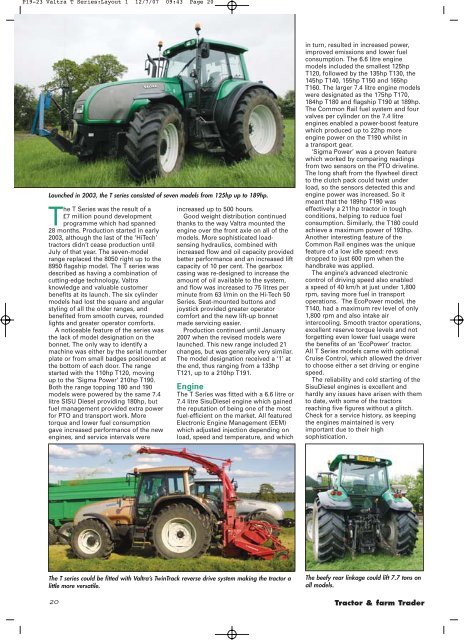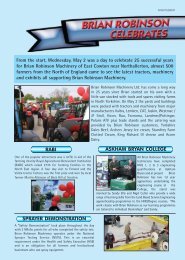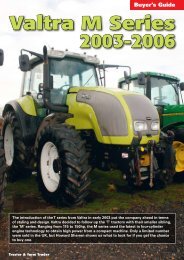july 07-buyers guide for t series valtra - Brian Robinson Machinery
july 07-buyers guide for t series valtra - Brian Robinson Machinery
july 07-buyers guide for t series valtra - Brian Robinson Machinery
You also want an ePaper? Increase the reach of your titles
YUMPU automatically turns print PDFs into web optimized ePapers that Google loves.
P19-23 Valtra T Series:Layout 1 12/7/<strong>07</strong> 09:43 Page 20<br />
Launched in 2003, the T <strong>series</strong> consisted of seven models from 125hp up to 189hp.<br />
The T Series was the result of a<br />
£7 million pound development<br />
programme which had spanned<br />
28 months. Production started in early<br />
2003, although the last of the ‘HiTech’<br />
tractors didn’t cease production until<br />
July of that year. The seven-model<br />
range replaced the 8050 right up to the<br />
8950 flagship model. The T <strong>series</strong> was<br />
described as having a combination of<br />
cutting-edge technology, Valtra<br />
knowledge and valuable customer<br />
benefits at its launch. The six cylinder<br />
models had lost the square and angular<br />
styling of all the older ranges, and<br />
benefited from smooth curves, rounded<br />
lights and greater operator com<strong>for</strong>ts.<br />
A noticeable feature of the <strong>series</strong> was<br />
the lack of model designation on the<br />
bonnet. The only way to identify a<br />
machine was either by the serial number<br />
plate or from small badges positioned at<br />
the bottom of each door. The range<br />
started with the 110hp T120, moving<br />
up to the ‘Sigma Power’ 210hp T190.<br />
Both the range topping 180 and 190<br />
models were powered by the same 7.4<br />
litre SISU Diesel providing 180hp, but<br />
fuel management provided extra power<br />
<strong>for</strong> PTO and transport work. More<br />
torque and lower fuel consumption<br />
gave increased per<strong>for</strong>mance of the new<br />
engines, and service intervals were<br />
increased up to 500 hours.<br />
Good weight distribution continued<br />
thanks to the way Valtra mounted the<br />
engine over the front axle on all of the<br />
models. More sophisticated loadsensing<br />
hydraulics, combined with<br />
increased flow and oil capacity provided<br />
better per<strong>for</strong>mance and an increased lift<br />
capacity of 10 per cent. The gearbox<br />
casing was re-designed to increase the<br />
amount of oil available to the system,<br />
and flow was increased to 75 litres per<br />
minute from 63 l/min on the Hi-Tech 50<br />
Series. Seat-mounted buttons and<br />
joystick provided greater operator<br />
com<strong>for</strong>t and the new lift-up bonnet<br />
made servicing easier.<br />
Production continued until January<br />
20<strong>07</strong> when the revised models were<br />
launched. This new range included 21<br />
changes, but was generally very similar.<br />
The model designation received a ‘1’ at<br />
the end, thus ranging from a 133hp<br />
T121, up to a 210hp T191.<br />
Engine<br />
The T Series was fitted with a 6.6 litre or<br />
7.4 litre SisuDiesel engine which gained<br />
the reputation of being one of the most<br />
fuel-efficient on the market. All featured<br />
Electronic Engine Management (EEM)<br />
which adjusted injection depending on<br />
load, speed and temperature, and which<br />
in turn, resulted in increased power,<br />
improved emissions and lower fuel<br />
consumption. The 6.6 litre engine<br />
models included the smallest 125hp<br />
T120, followed by the 135hp T130, the<br />
145hp T140, 155hp T150 and 165hp<br />
T160. The larger 7.4 litre engine models<br />
were designated as the 175hp T170,<br />
184hp T180 and flagship T190 at 189hp.<br />
The Common Rail fuel system and four<br />
valves per cylinder on the 7.4 litre<br />
engines enabled a power-boost feature<br />
which produced up to 22hp more<br />
engine power on the T190 whilst in<br />
a transport gear.<br />
‘Sigma Power’ was a proven feature<br />
which worked by comparing readings<br />
from two sensors on the PTO driveline.<br />
The long shaft from the flywheel direct<br />
to the clutch pack could twist under<br />
load, so the sensors detected this and<br />
engine power was increased. So it<br />
meant that the 189hp T190 was<br />
effectively a 211hp tractor in tough<br />
conditions, helping to reduce fuel<br />
consumption. Similarly, the T180 could<br />
achieve a maximum power of 193hp.<br />
Another interesting feature of the<br />
Common Rail engines was the unique<br />
feature of a low idle speed: revs<br />
dropped to just 600 rpm when the<br />
handbrake was applied.<br />
The engine’s advanced electronic<br />
control of driving speed also enabled<br />
a speed of 40 km/h at just under 1,800<br />
rpm, saving more fuel in transport<br />
operations. The EcoPower model, the<br />
T140, had a maximum rev level of only<br />
1,800 rpm and also intake air<br />
intercooling. Smooth tractor operations,<br />
excellent reserve torque levels and not<br />
<strong>for</strong>getting even lower fuel usage were<br />
the benefits of an ‘EcoPower’ tractor.<br />
All T Series models came with optional<br />
Cruise Control, which allowed the driver<br />
to choose either a set driving or engine<br />
speed.<br />
The reliability and cold starting of the<br />
SisuDiesel engines is excellent and<br />
hardly any issues have arisen with them<br />
to date, with some of the tractors<br />
reaching five figures without a glitch.<br />
Check <strong>for</strong> a service history, as keeping<br />
the engines maintained is very<br />
important due to their high<br />
sophistication.<br />
The T <strong>series</strong> could be fitted with Valtra’s TwinTrack reverse drive system making the tractor a<br />
little more versatile.<br />
The beefy rear linkage could lift 7.7 tons on<br />
all models.<br />
20 Tractor & farm Trader







